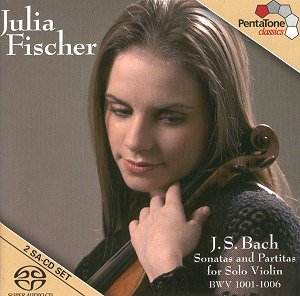Comparison recordings
Johanna Martzy, violin. EMI [ADD monophonic]
7243 4 89179 2 8
Ralph Schroeder, violin & arc bow.
CBS Columbia LP ML 4744 [V.II]
Paul Galbraith, 8 string guitar. Delos
DE 3232
Having been a fan of
Julia Fischer from my first encounter
with her, I leapt on this disk with
the highest expectations. I was not
disappointed. Julia Fischer is no longer
a talented child; she is a highly skilled
young woman of 21 who, as preparation
for these recordings, played on the
piano the Busoni transcription of the
ciaccona (!) then began to expand
her own violin performance in light
of what Busoni had shown was possible.
In the interview with Harriet Smith,
Fischer tells us in her delightful manner
and fluent English how she grew up in
a musical household, how it was only
an accident that she became a violinist
instead of a pianist and that she feels
at home on both instruments.
The argument that a
21 year old canít play profound music
because she hasnít suffered enough is
belied by the fact that we do most of
our suffering during adolescence; note
the high suicide rate for teenagers.
If we are lucky, as we age we gain compassion,
insight, toleration, and we become weaker
in the face of what sufferings remain.
Hopefully, experience should teach us
that other people have good ideas, too,
and we become less assertive of our
originality. But, most important, we
lose finger co-ordination, so however
Julia Fischer plays these works when
she is sixty, she wonít play them with
as much confidence or agility or purity
as she plays them right now. You may
want to buy this disk now for comparison
later, as there is no doubt we will
be hearing a great deal from Julia Fischer
in the years to come.
This is awkward music
to play, the more difficult pieces all
but impossible to play with perfect
grace, at least with a modern straight
high-tension bow. Ralph Schroeder recorded
them on CBS LP with a low tension arced
bow which made arpeggiating the chords
unnecessary; all the notes of the chords
could be played simultaneously. It made
for an odd but relaxed sound and perhaps
impaired his agility in faster passages.
No modern violinist has adopted the
arced bow, and the efforts of recent
performers to achieve smooth as well
as agile performances have been remarkable.
There is a danger here in that playing
the works so they sound easy will make
them sound superficial, whereas in earlier
recordings the performerís struggle
may have inappropriately contributed
to the drama. We need to remember that
however he himself played them, Bach
never struggled, and probably dashed
the works off at break-neck speed.
The Martzy recording
is the finest previous violin recording
by a woman and in many ways the finest
recording of these works ever done.
Fischerís performance is higher energy,
more graceful, less mystical, but no
less precise and assured, and possibly
even more secure in pitch. Compared
with anyone, Fischerís ciaccona
is a magnificent achievement, one of
the very best, as are her fugas
in g and C, and her preludio
in E. Am I ready to transfer my allegiance
from Martzy to Fischer? Iím thinking
about it. Paul Galbraithís guitar transcription
is amazingly successful particularly
in the fugues and shorter pieces. That
said, his proposal that Bach considered
the ciaconna to represent the
progress of Jesusí steps towards Calvary
results in a morbid but not notably
insightful performance of that piece,
rather lacking in drama and variety
of tone.
Why do we need SACD
for violin recording? I remember when
stereo LPs cost a dollar more than monophonic
we would debate with ourselves whether
stereo was worth a dollar or not. But
violin sound is one of the most difficult
sounds there is to record, and it uses
every bit of the full range of the SACD
if realism is to be attained. I came
to listen to these recordings direct
from a live solo violin concert and
at once appreciated what had been accomplished
here, evident even on the CD tracks
on this hybrid disk. Listen to the CD
tracks and be impressed; then listen
to the SACD tracks and be bowled over.
Paul Shoemaker







